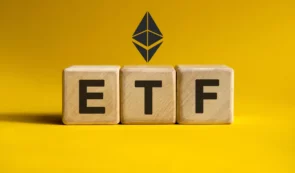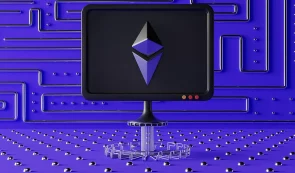What is Ethereum
Ethereum is an open-source platform that allows developers to create and implement decentralized applications such as smart contracts and other complex legal and financial applications. The cryptocurrency with the second-largest market capitalization bears the same name, and many even believe it will overtake Bitcoin at some point.
In 2013, Bitcoin Magazine’s co-founder, Vitalik Buterin, shared Ethereum’s whitepaper. The project description claims that Bitcoin needs a scripting language to develop applications. But when it failed to reach the necessary agreement, it proposed creating a new platform with a more general scripting language. About the Ethereum project, Buterin said:
“I’m really grateful to have the opportunity to work in such an interesting and interdisciplinary area of the industry where I can interact with cryptographers, mathematicians and, economists, celebrities in their fields. I want to help build software and tools that already affect tens of thousands of people around the world and work weekly on advanced problems in computer science, economics, and philosophy.”
A brief chronology
- November 2013: Vitalik Buterin published the Ethereum whitepaper.
- January 2014: The development of the Ethereum platform was publicly announced. The original Ethereum development team consisted of Vitalik Buterin, Mihai Alisie, Anthony Di Iorio, and Charles Hoskinson
- August 2014: Ethereum completes its ICO and raises $18.4 million
- May 2015: Ethereum test network, Olympic (Ethereum 0.9), is released
- July 30, 2015: The first stage of Ethereum development, Frontier, is released
- March 14, 2016: Homestead, the first “stable” version of Ethereum, is released at block 1,150,000
- June 2016: The DAO hack happened, and $50 million worth of Ether, 15% of the total supply at the time, disappeared
- October 25, 2016: Ethereum hard fork – Ethereum Classic (ETC) emerges.
- October 16, 2017: Byzantium update
- February 28, 2019: Constantinople update
- December 08, 2019: Istanbul update
- January 02, 2020: Muir Glacier update
- October 14, 2020: Ethereum launches the staking contract
- December 01, 2020: Beacon Chain genesis
- April 15, 2021: Berlin update
- August 05, 2021: London update
- October 27, 2021: Altair update
- December 09, 2021: Arrow Glacier update
- June 30, 2022: Gray Glacier update
How Ethereum works
Ethereum is based on the consensus protocol mechanism for Proof-of-Stake (PoS) following its migration in 2022 from Proof-of-Work (PoW). PoS is a blockchain technology that enables higher levels of scalability and transaction security. Unlike a traditional PoW system, where the process of mining is performed to add new blocks to the chain, PoS requires miners to provide a portion of their coins as collateral to validate transactions on the network.
When operating a PoS-based network, miners deposit (stake) their coins as collateral. Validators are responsible for creating consensus in the blockchain by verifying each new batch of transactions before they are added to the public ledger. They also receive rewards when they successfully validate blocks and can incur penalties if they fail to do so.
From the project’s early days, Ethereum planned to move from the PoW algorithm to PoS, with the main idea being to solve the network’s problems with transaction speed and cost efficiency.
Ethereum enables developers to create decentralized applications. A decentralized application, or dApp, serves a specific purpose to users. Bitcoin, for example, is a dApp that provides its users with an e-cash system that enables online payments with the asset. Because decentralized applications are composed of code that runs on a blockchain network, they are not controlled by any individual or central authority.
Any centralized services can be decentralized using Ethereum. Think of all the intermediary services that exist in hundreds of different industries, from services such as loans provided by banks to intermediary services that are rarely offered by most people, such as property records, voting systems, regulatory compliance, and much more.
The difference between Bitcoin and Ethereum
Is Ethereum similar to Bitcoin? The answer is yes and no.
Like Bitcoin, Ethereum is a distributed public blockchain network. While there are some significant technical differences between the two, the most vital distinction is the intended use and the opportunities arising from them. Bitcoin offers one particular application of blockchain technology, an electronic money system that allows online payments with Bitcoin – peer-to-peer (P2P).
While Bitcoin’s blockchain is used to track ownership of the digital currency, Ethereum’s blockchain focuses on executing the programming code of each decentralized application.
With Etherium, instead of mining BTC, miners work to earn ether (ETH), a type of cryptocurrency that powers the network. Beyond tradable cryptocurrency, ether is also used by app developers to pay transaction fees and services on the network.
Miners pay a so-called “gas” fee to include transactions in their block. Each execution of the smart contract requires a certain amount of gas to be sent to get the miners to add the transaction to the blockchain.
While all blockchain networks can process code, most are severely limited. Ethereum is different. Instead of giving a set of limited operations, this blockchain allows developers to create whatever they want. This means they can create thousands of different applications that surpass anything we’ve seen before.
What is the gas in Ethereum’s network?
In theory, gas is a unit of measurement for the computational work of transactions or smart contracts executed by miners on their own account to keep the Ethereum network running.
It is the fee or pricing value required to successfully complete a transaction or execute a contract on the Ethereum blockchain platform. Priced in small fractions of the cryptocurrency ETH, commonly called gwei and sometimes nanoeth, the gas is used to allocate resources on the Ethereum Virtual Machine (EVM) so that decentralized applications, such as smart contracts, can self-execute in a secure but decentralized manner.
The exact price of gas is determined by supply and demand between the miners of the network, who can refuse to process a transaction if the gas price does not meet their threshold, and the users of the network, who seek computing power.
What is a smart contract?
Ethereum works with smart contracts, which is computer code that defines the guidelines of a contract and then ensures that the parties involved execute it following those terms.
Blockchain technology allows two parties to initiate and execute a smart contract between themselves without using a traditional third-party intermediary. Smart contracts are transparent and immutable, making it impossible for one party later to change the terms of the contract to their advantage.
Most people think of contracts in legal terms. Smart contracts can involve legal issues but often do not. They are simply lines of code that perform a function.
You can think of a smart contract as specialized business software. Developers create smart contracts to run their applications. Because these applications run on a decentralized network, they are called decentralized applications or dApps.
What is an Ethereum Virtual Machine (EVM)?
Virtual machines attempt to reach a higher level of abstraction than your usual operating system or OS. Unlike Windows or iOS, virtual machines are created on top of the regular operating systems to function similarly to physical computing machines.
In other words, virtual machines approximate the computing power of physical machines by using a virtual architecture. They can run on many different types of operating systems and hardware, making them an ideal engine for a decentralized ecosystem.
EVM allows developers to create smart contracts in a programming language called Solidity. A popular use of smart contracts is to manage the generation and exchange of tokens. Many applications and protocols use tokens to reward users for actions that are important to their purpose. Without EVM, none of this would be possible.
The Merge
The Merge describes the event where Ethereum transitions from a Proof-of-Work (PoW) consensus mechanism to a Proof-of-Stake (PoS).
Ethereum initially launched a separate Beacon Chain on December 01, 2020. It operated in parallel with the main Ethereum network.
On September 06, 2022, the Ethereum community released a Bellatrix update to begin the “The Merge.” With this first upgrade, the community decided to replace the PoW chain with a PoS-based one when a certain Total Terminal Difficulty (TTD) value was reached in the original Ethereum blockchain.
However, the Merge itself does not solve the problem of high gas fee prices – it only starts a set of improvements that will ultimately reduce costs. These improvements were known as Ethereum 2.0, but that terminology was abandoned in early 2022.



